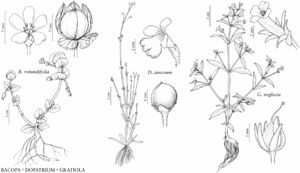Gratiola
Sp. Pl. 1: 17. 1753.
Herbs, annual or perennial. Stems decumbent to ascending or erect, glabrous or glandular-hairy. Leaves cauline (also basal and clustered in G. amphiantha), opposite, monomorphic (dimorphic in G. amphiantha); petiole absent; blade not fleshy, not leathery, margins entire or toothed, surfaces often glandular-punctate. Inflorescences axillary, flowers 1 or 2 per node; bracts present. Pedicels present, sometimes short; bracteoles present or absent, sepal-like. Flowers bisexual; sepals 5, distinct or proximally connate, calyx ± bilaterally symmetric, campanulate, lobes (sepals when distinct) linear to lanceolate, obovate, or oblong; corolla white, cream, or yellow, sometimes pinkish, tube yellowish, brownish, or purplish, often with dark veins, bilaterally symmetric, bilabiate, tubular, tube base not spurred or gibbous, lobes 5, abaxial 3, adaxial 2, nearly completely connate and appearing as 1 emarginate lobe, throat glabrous or pubescent; stamens 2, medially adnate to corolla, filaments glabrous, pollen-sacs perpendicular to filaments, connective dilated; staminodes 0 or 2, minute; ovary 2-locular, placentation axile; stigma capitate or lamelliform. Fruits capsules, dehiscence septicidal, sometimes also loculicidal. Seeds ca. 200, yellow to brown or black, oblong to obpyramidal or short-cylindric, wings absent. × = 9.
Distribution
North America, Mexico, Central America (Guatemala), South America, Europe, e Asia (Japan), Africa (Morocco), Pacific Islands (New Zealand), Australia
Discussion
Species ca. 30 (13 in the flora).
Members of Gratiola sometimes are confused with Lindernia and Mecardonia. Sophronanthe often is included in Gratiola; molecular and morphological data support separating the two as sister genera (D. Estes 2008).
This treatment was prepared in part from information contained in a partial manuscript submitted by D. Estes.
Selected References
Lower Taxa
Key
| 1 | Capsules bilaterally symmetric; leaves dimorphic, submersed blades usually narrower than floating blades. | Gratiola amphiantha |
| 1 | Capsules ± radially symmetric; leaves monomorphic, submersed blades absent or, if present, similar to emersed blades. | > 2 |
| 2 | Perennials. | > 3 |
| 3 | Bracteoles 0 or 1; leaf blades linear-lanceolate to lanceolate-ovate, 1–3 mm wide, margins entire or with 1 or 2(or 3) pairs of blunt teeth. | Gratiola ramosa |
| 3 | Bracteoles (1 or)2; if 1, leaf blades lanceolate to lanceolate-ovate, ovate, or oblong, rarely linear-lanceolate, (1–)3–8(–13) mm wide, margins with (1 or)2–4 pairs of sharp teeth. | > 4 |
| 4 | Corolla limbs yellow, rarely white or cream, veins yellow to orangish yellow, rarely white; pedicels sparsely glandular-puberulent. | Gratiola lutea |
| 4 | Corolla limbs white, veins yellow, brownish yellow, blue, or lavender; pedicels sparsely to densely glandular-puberulent to glandular-pubescent. | > 5 |
| 5 | Leaf blade margins with (1 or)2–4 pairs of teeth, blades lanceolate to lanceolate-ovate or oblong; corolla veins yellow or brownish yellow; sepals linear-lanceolate. | Gratiola brevifolia |
| 5 | Leaf blade margins with (3–)5–10(–12) pairs of teeth, blades lanceolate-ovate to ovate or oblong, rarely linear-lanceolate in submersed forms; corolla veins blue or lavender; sepals lanceolate to elliptic or ovate-lanceolate. | Gratiola viscidula |
| 2 | Annuals. | > 6 |
| 6 | Bracteoles 0; w North America. | > 7 |
| 7 | Calyces slightly bilaterally symmetric, sepals distinct, (4–)7–11 mm, lanceolate; leaf blade apices acuminate to attenuate. | Gratiola ebracteata |
| 7 | Calyces distinctly bilaterally symmetric, sepals connate proximally, lobes 3.5–6 mm, elliptic-oblanceolate; leaf blade apices obtuse to rounded. | Gratiola heterosepala |
| 6 | Bracteoles 1 or 2; e, c, or w North America. | > 8 |
| 8 | Corolla limbs yellow; capsules ovoid. | Gratiola torreyi |
| 8 | Corolla limbs white, sometimes tinged pink, lavender, or purple; capsules ovoid to short-cylindric or subglobular. | > 9 |
| 9 | Pedicels stout, 1–12 mm, lengths 0.1–0.3 times bracts. | Gratiola virginiana |
| 9 | Pedicels slender, (5–)7–45(–55) mm, lengths (0.3–)0.4–2(–2.3) times bracts. | > 10 |
| 10 | Corollas 14–25 mm; pedicels 20–45(–55) mm. | Gratiola floridana |
| 10 | Corollas 7–12 mm; pedicels (5–)7–35 mm. | > 11 |
| 11 | Leaf blades 6–13(–18) mm; pedicel lengths 0.9–2(–2.3) times bracts; granite outcrops. | Gratiola graniticola |
| 11 | Leaf blades 10–65 mm; pedicel lengths (0.3–)0.4–1(–1.6) times bracts; wet meadows, stream banks, shores of ponds, mudflats, salt marshes, crop fields, seeps, pools, and streams in limestone and dolomite glades, calcareous grasslands. | > 12 |
| 12 | Leaf blades linear to narrowly elliptic, oblanceolate, or elliptic-obovate, rarely falcate, 3–11(–18) mm wide, margins with (1 or)2–5(–7) pairs of blunt to sharp teeth, rarely entire; wet meadows, stream banks, shores of ponds, mudflats, salt marshes, crop fields. | Gratiola neglecta |
| 12 | Leaf blades linear to linear-lanceolate or lanceolate-elliptic, often falcate, (1–)2.5–5 mm wide, margins entire or with 1 or 2(or 3) pairs of blunt teeth distally; seeps, pools, and streams in limestone and dolomite glades, calcareous grasslands. | Gratiola quartermaniae |

